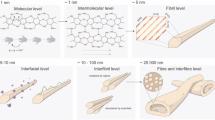Abstract
A facile protocol to prepare CMC/CNC suspensions with high yield of CNCs is presented, where CMC was used in combination with mechanical shearing to promote delamination of the cellulose fiber wall. The maximum yield of CNCs in the CMC/CNC suspension was 41.6%. Compared with a purely mechanical method, the yield of CNCs has been increased by 103%. The diameter and length of the obtained CNCs were 20–45 and 200–250 nm separately. The thermal stability of CNCs was higher than acid derived CNCs due to the unmodified surface groups. Thin films of neat CMC and CMC/CNC composites were prepared by solution casting. The SEM results showed good dispersion of CNCs in the matrix. The tensile strength of the film was increased compared with neat CMC film.
Graphical abstract
A facile protocol to prepare CMC/CNC suspension with high yield of CNCs is presented, where CMC is used in combination with mechanical shearing to promote delamination of the cellulose fiber wall.









Similar content being viewed by others
References
Abe K (2016) Nanofibrillation of dried pulp in NaOH solutions using bead milling. Cellulose 23:1257–1261
Agarwal D, MacNaughtan W, Foster TJ (2018) Interactions between microfibrillar cellulose and carboxymethyl cellulose in an aqueous suspension. Carbohyd Polym 185:112–119
Avolio R, Bonadies I, Capitani D, Errico ME, Gentile G, Avella M (2012) A multitechnique approach to assess the effect of ball milling on cellulose. Carbohyd Polym 87:265–273
Ballesteros JEM, Santos SF, Mármol G, Savastano H, Fiorelli J (2015) Evaluation of cellulosic pulps treated by hornification as reinforcement of cementitious composites. Constr Build Mater 100:83–90
Chen L, Zhu JY, Baez C, Kitin P, Elder T (2016) Highly thermal-stable and functional cellulose nanocrystals and nanofibrils produced using fully recyclable organic acids. Green Chem 18:3835
Cranston ED, Gray DG (2006) Morphological and optical characterization of polyelectrolyte multilayers incorporating nanocrystalline cellulose. Biomacromol 7:2522–2530
Djafari Petroudy SR, Ranjbar J, Rasooly Garmaroody E (2018) Eco-friendly superabsorbent polymers based on carboxymethyl cellulose strengthened by TEMPO-mediated oxidation wheat straw cellulose nanofiber. Carbohyd Polym 197:565–575
Fu J, Li D, Li G, Huang F, Wei Q (2015a) Carboxymethyl cellulose assisted immobilization of silver nanoparticles onto cellulose nanofibers for the detection of catechol. J Electroanal Chem 738:92–99
Fu J, Pang Z, Yang J, Huang F, Cai Y, Wei Q (2015b) Fabrication of polyaniline/carboxymethyl cellulose/cellulose nanofibrous mats and their biosensing application. Appl Surf Sci 349:35–42
Huang P, Wu M, Kuga S, Wang D, Wu D, Huang Y (2012) One-step dispersion of cellulose nanofibers by mechanochemical esterification in an organic solvent. Chemsuschem 5:2319–2322
Huang P, Zhao Y, Kuga S, Wu M, Huang Y (2016) A versatile method for producing functionalized cellulose nanofibers and their application. Nanoscale 8:3753–3759
Iwamoto S, Nakagaito AN, Yano H (2007) Nano-fibrillation of pulp fibers for the processing of transparent nanocomposites. Appl Phys A 89:461–466
Jia C et al (2017) Thermally stable cellulose nanocrystals toward high-performance 2D and 3D nanostructures. ACS Appl Mater Interfaces 9:28922–28929
Kang X, Kuga S, Wang C, Zhao Y, Wu M, Huang Y (2018) Green preparation of cellulose nanocrystal and its application. ACS Sustain Chem Eng 6:2954–2960
Laine J (2000) Studies on topochemical modification of cellulosic fibres. Part 1. Chemical conditions for the attachment of carboxymethyl cellulose onto fibres. Nord Pulp Pap Res J 15:520–526
Liu A, Berglund LA (2013) Fire-retardant and ductile clay nanopaper biocomposites based on montmorrilonite in matrix of cellulose nanofibers and carboxymethyl cellulose. Eur Polym J 49:940–949
Lowys MP, Desbrières J, Rinaudo M (2001) Rheological characterization of cellulosic microfibril suspensions. Role of polymeric additives. Food Hydrocolloids 15:25–32
Mazhari Mousavi SM, Afra E, Tajvidi M, Bousfield DW, Dehghani-Firouzabadi M (2017) Cellulose nanofiber/carboxymethyl cellulose blends as an efficient coating to improve the structure and barrier properties of paperboard. Cellulose 24:3001–3014
Moon RJ, Martini A, Nairn J, Simonsen J, Youngblood J (2011) Cellulose nanomaterials review: structure, properties and nanocomposites. Chem Soc Rev 40:3941–3994
Saito T, Hirota M, Tamura N, Kimura S, Fukuzumi H, Heux L, Isogai A (2009) Individualization of nano-sized plant cellulose fibrils by direct surface carboxylation using TEMPO catalyst under neutral conditions. Biomacromol 10:1992–1996
Seifert M, Hesse S, Kabrelian V, Klemm D (2004) Controlling the water content of never dried and reswollen bacterial cellulose by the addition of water-soluble polymers to the culture medium. J Polym Sci Part A Polym Chem 42:463–470
Song K, Ji Y, Li W, Wei Y, Yu Z (2018) A green and environmental benign method to extract cellulose nanocrystal by ball mill assisted solid acid hydrolysis. J Clean Prod 196:1169–1175
Wang N, Ding E, Cheng R (2007) Thermal degradation behaviors of spherical cellulose nanocrystals with sulfate groups. Polymer. https://doi.org/10.1016/j.polymer.2007.03.062
Acknowledgments
This work was supported by the National Natural Science Foundation of China (No. 51733009), the Natural Science Foundation of Hebei Province (No. E2018210125) and Hebei Key Discipline Construction Project.
Author information
Authors and Affiliations
Contributions
The manuscript was written through contributions of all authors. All authors have given approval to the final version of the manuscript.
Corresponding authors
Additional information
Publisher's Note
Springer Nature remains neutral with regard to jurisdictional claims in published maps and institutional affiliations.
Electronic supplementary material
Below is the link to the electronic supplementary material.
Rights and permissions
About this article
Cite this article
Lin, X., Guo, X., Xu, C. et al. Carboxymethyl cellulose assisted mechanical preparation of cellulose nanocrystals with high yield. Cellulose 26, 5227–5236 (2019). https://doi.org/10.1007/s10570-019-02452-7
Received:
Accepted:
Published:
Issue Date:
DOI: https://doi.org/10.1007/s10570-019-02452-7




